Worried about moonlight washing out the Geminid meteor shower? Here's what you need to know to make the most of this year's display.
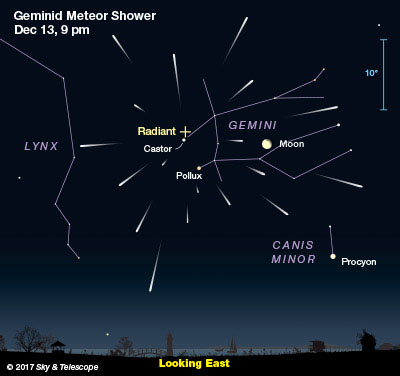
The annual Geminid meteor shower peaks on Friday night, December 13–14, when upwards of 100 meteors per hour are typically seen from a pristine site under moonless conditions. But this year, there's one little problem: the sky won't be moonless. A fat, waning gibbous sits smack in the middle of Gemini, not far from the shower's radiant.
Bad news, right? Yes and no. If we assume the Moon will pare down the display by two-thirds, that still leaves 20-30 meteors per hour. To put those numbers in context, the diminished Geminids still equal or better the well-known Leonid, Orionid, and Lyrid showers viewed under ideal conditions. It doesn't hurt that the Geminids are also known for producing lots of fireballs — exceptionally luminous streaks that flare to magnitude –4 or brighter. Bottom line: I'll be watching, and hope you will too.
Although the meteoric fusillade peaks at around 12h UT (7 a.m., EST) on December 14, you don't have to get up before dawn to catch Geminids. The radiant stands reasonably high in the eastern sky by 9 p.m., local time. That's early enough for kids to watch. Indeed, I strongly encourage parents to share the experience with their children.
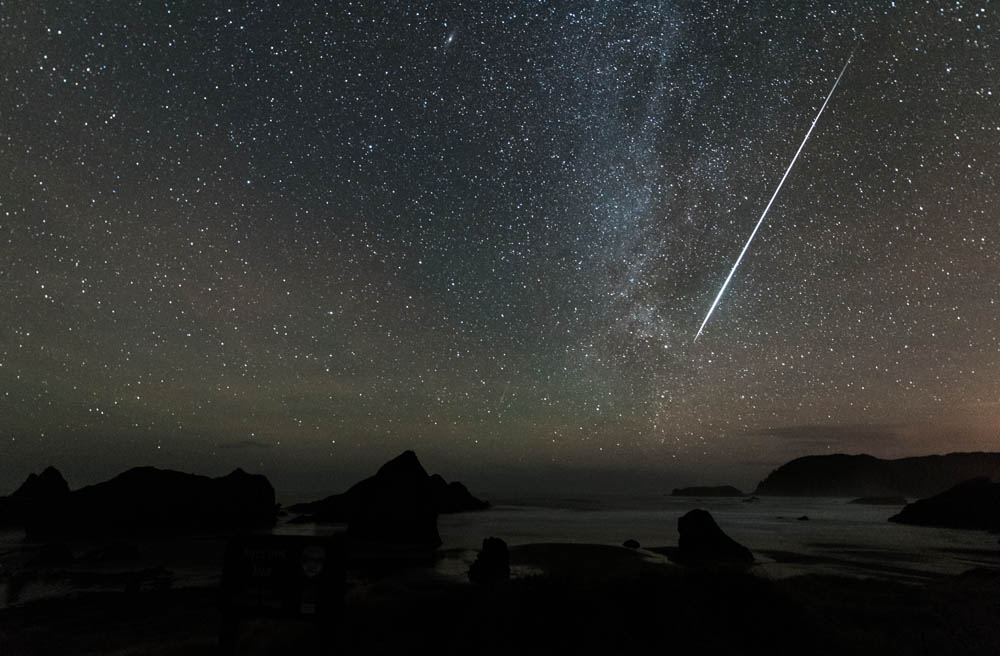
Courtesy Ranbo55
While I've done plenty of solo meteor-gazing, my favorite memories are the mingled quiet talk and excitement I've experienced while watching the Perseids and Leonids with my daughters. Not only do extra sets of eyes capture more meteors, but children get the opportunity to make friends with the stars... and wonder. I find that nearly everyone — adults and kids alike — feels more comfortable asking big-picture questions under the bowl of night.
When and Where
I checked my scribblings from last year's display and noted that activity picked up as early as 9 p.m., local time. If you need to get to bed early, you can net a few meteors in just one hour, from 9 until 10 p.m., on Friday evening (December 13). But if you can swing it, expand your viewing session to include the hours of 10 p.m. through midnight, when the radiant is higher.
You can begin your watch at the end of twilight when Geminid earthgrazers are on the prowl. These bright, slow-moving meteors appear to stream from the northeast when the shower radiant is near the horizon. They sail across the sky and incinerate slowly as the particles skim the upper atmosphere nearly parallel to the ground.
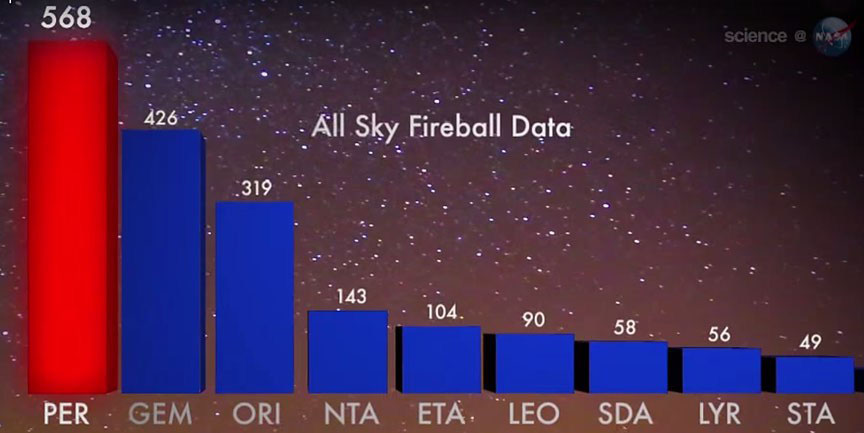
NASA
No matter when you choose to view, it's a good idea preserve your night vision and avoid looking directly at the Moon. For a nice mix of short- and long-trailed meteors, I suggest facing north or south during evening hours. (Although Geminids can appear anywhere in the sky, they seem to originate from the shower's radiant point, located near the star Castor, as shown in the chart at the top of the page.) The maximum number of meteors will be visible when the radiant reaches the meridian, at roughly 1 a.m. local time, on December 14. At that hour, look any direction but straight up.
Should poor weather threaten, bear in mind that the display is productive from December 12-15, though with significantly fewer meteors visible on non-peak nights. Socked in by clouds? You can watch the shower in real time on your phone or computer courtesy of Italian astronomer Gianluca Masi, who will live-stream the event starting at 4:00 UT, Dec. 14 (11 p.m. EST, Dec. 13).
As for me, I like to kick back in a reclining lawn chair and huddle under a sleeping bag for warmth. A thermos of hot chocolate helps keep the December chill at bay and makes a welcomed enticement for the kids. I also keep track of meteor showers with an informal count — my best was 85 Geminids in two hours under dark skies in 2018.
Curious Origins
Geminids strike the atmosphere at 35 kilometers per second (78,000 mph), which is poky compared to the Perseids and Orionids, which rip by at nearly twice that speed. Geminids tend to be bright and colorful, but owing to their comparatively slow velocities, don't produce as many trains — lingering streaks of ionized air created by particles that range in size from fine dust to small rocks weighing a couple grams.

Ingvars Tomsons / CC SA-BY 4.0
While the Perseids and Taurids are examples of meteor showers that have been observed for centuries, the Geminids are relatively new. They made their first appearance in the mid-19th century, and since then have gradually intensified to become one of the richest displays of the year. Unlike most other showers, the Geminids originate from an asteroid, not a comet. Their parent body is 3200 Phaethon (FAY-eh-thon), a potentially-hazardous asteroid that orbits the Sun in a highly elongated ellipse every 1.4 years. At perihelion it approaches nearer to our star (within 33.6 million km) than any other named asteroid. Although Phaethon's spectrum indicates a rocky composition, it has exhibited cometary characteristics on several occasions, including sprouting a dust tail some 250,000 km long.
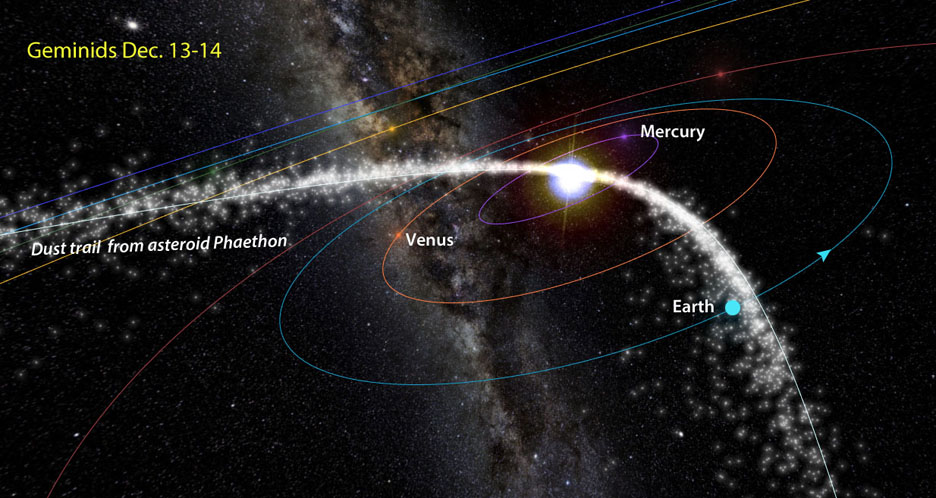
Peter Jenniskens and Ian Webster
In a 2013 paper American astronomer David Jewitt proposed that the particles comprising Phaethon's tail "are likely products of thermal fracture and/or desiccation cracking under the very high surface temperatures (∼1000 K) experienced by Phaethon at perihelion." Every December, when Earth passes through that debris trail, we get to enjoy the Geminid meteor shower.
More Fun to Come
The Geminids kick off a trifecta of meteor showers peaking in the coming weeks. Next up are the Ursids which emanate from near the star Kochab, in the bowl of the Little Dipper. This particles in this display originate from comet 8P/Tuttle.
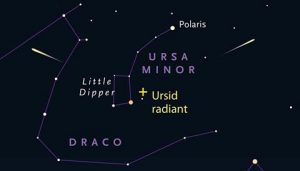
A maximum of 10 meteors an hour are expected overnight on December 21–22, with the Ursid peak occurring around 2h UT, December 23rd (7 p.m. EST, Dec. 22nd). Meteor specialist Peter Jenniskens predicts a spike in activity, with double or triple the usual rate, just before 22h on December 22 — an ideal time for skywatchers in Europe, Africa and western Asia. The Moon will be a waning crescent that night and pose no problem.
You won't want to miss our third meteor event, the Quadrantids, which max out around 8:00 UT (3 a.m. EST) on January 4th. The Quads have an extremely narrow peak lasting just hours, but if those hours coincide with a dark, pre-dawn sky at your location, you're in for a treat. Watch for my write-up on this display, appearing early in the new year.
 4
4









Comments
ngc4565
December 14, 2019 at 12:54 pm
Hello Bob, last night here in England, I was attempting to get a wide angle cmos shot of M42 despite the rolling clouds and the moon washing everything out. About 12.30 I saw a massive fireball shoot fron the Gemini region lasting 2 to 3 seconds at least. Totally forgot it was the Geminid shower until I saw your article, so I am supposing that's what I've seen a part of. Anyway, it was fantastic. All the best. K.
You must be logged in to post a comment.
Bob KingPost Author
December 14, 2019 at 9:34 pm
Wow, Kbro — sounds amazing! It sure could have been a Geminid fireball. Did it stream from the direction of the constellation?
You must be logged in to post a comment.
Rod
December 15, 2019 at 12:05 am
Bob King et al. Rod in Maryland did see some Geminids tonight! Yesterday and this morning - clouds and light rain but later tonight, skies started to clear. I was out in Maryland from 2100-2330 EST observing. Here is a note from my log "Waning gibbous Moon in Cancer this evening. I went out with my 10x50 binoculars and tried to observe some Geminids tonight and binocular views of the Moon, and M42 in Orion. I did enjoy some views of the Moon and M42 using the binoculars. The Geminids radiant was up. Lovely evening with altocumulus clouds illuminated by waning gibbous moonlight. Orion visible, Sirius, the Pleiades in Taurus, Capella in Auriga, Cassiopeia. There were large breaks in the clouds. I did observe two Geminids flash by moving towards Cassiopeia, away from the radiant. They were both about as bright as Capella in Auriga. Starry Night reports the Geminids travel about 35 km/s, so does Stellarium 0.19.2. My flip cell phone time check showed 2140 EST and 2142 EST. Later near 2305 EST, I observed a bright meteor flash by Orion heading south. The meteor disappeared behind altocumulus clouds in the south sky but I estimate it was about as bright as Sirius in Canis Major. The altocumulus clouds and cirrus clouds - more moved in so I decided to end the observation run for Geminids this evening near 2330 EST. There were two fainter Geminids I saw move through Auriga but they were fainter, near mv +4.0 or fainter. The waning gibbous Moon with altocumulus clouds and cirrus - caused problems viewing tonight but the moonlight on the clouds provided an ethereal sky. Temperature not bad tonight, 5C while viewing.
You must be logged in to post a comment.
Bob KingPost Author
December 15, 2019 at 11:43 am
Rod,
Happy to hear you spotted a few even though it was past maximum. Get ready for the Ursids!
You must be logged in to post a comment.
You must be logged in to post a comment.